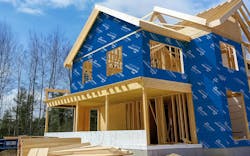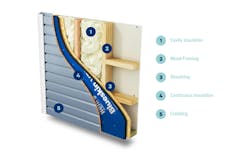Four Reasons Builders Use Continuous Insulation for Energy Efficiency
As residential construction continues to advance toward building zero-energy homes, builders are increasingly challenged to make their homes more energy efficient. The building envelope in particular is receiving a lot of attention, as it represents the front line of improving efficiency. One piece of the building envelope that has been embraced by builders is continuous insulation (CI). This insulating solution comes in varied forms from board to spray foam, and it’s a prime example of how product innovation can improve energy efficiency and help builders comply with code.
New Building Envelope Innovations Improve on CI
Building on the concept of CI for increasing energy efficiency, manufacturers like Henry® are taking the technology one step further. Innovations like new Blueskin® VPTech™ integrate R5 GPS CI, a weather-resistive barrier (WRB), and a pre-applied seam-sealing system into a single-step product. This combined solution offers multiple benefits to home builders who are balancing the pressures of meeting codes and customer demand with controlling costs and keeping construction schedules in check.
To understand how this innovation better serves builders and their buyers, here’s a look at four reasons builders choose CI and how Blueskin VPTech benefits apply to each one.
“I Believe in Sustainability”
Some home builders have focused on sustainability from the outset, building their reputations on a commitment to sustainable construction practices, energy efficiency, and environmentally friendly materials. For builders who embrace sustainability as their mission, CI has played an important part by lowering home energy use to reduce greenhouse gas emissions and shrink carbon footprints. New integrated panels further improve on these benefits by delivering weatherization, insulation, and seam sealing all at once. This represents a significant leap forward in building envelope technology, allowing builders to construct homes that are more energy efficient and that will perform better and last longer.
The longevity of a home is a hallmark of sustainability, and protecting critical structures from the elements is where integrated panels like Blueskin VPTech shine. The combination of WRB, Type II nominal 1” R5 GPS insulation, and the pre-applied seam-sealing tape address important building envelope issues that directly impact longevity. For instance, the WRB eliminates air gaps and water and moisture intrusion, and it self-seals around fasteners to protect the integrity of the seal. The high-performance insulating material uses graphite particles to reflect and absorb radiant energy and deliver long-term thermal resistance, and a micro-perforated metallicized polymeric backer lets moisture escape from the wall cavity, preventing condensation, mold growth, and rot. To complete the design, the panel features a pre-applied seam-sealing tape and release liner. This simple but important feature makes it easier than ever before to create uniform air- and water-tight seals. All these features work in harmony to improve energy efficiency, extend the life of the home, and contribute positively to sustainability.
“I Have to Comply With Regulation and Code”
The 2021 International Energy Conservation Code (IECC) represents a 40% increase in energy efficiency improvement for residential buildings versus 2006, and building codes and regulations are becoming notably more stringent. The 2018 and 2021 IECC insulation requirements for wood frame walls don’t explicitly require but strongly recommend exterior continuous insulation to meet minimum R-values in climate zones 3 through 8. To meet these higher standards, integrated panels deliver a continuous seal, creating air- and water-tight barriers and superior thermal resistance.
Meeting code doesn’t have to mean sacrificing productivity. The Blueskin VPTech integrated panel is lightweight, easy to cut, and does not require any special tools or skills to install. The pre-applied seam-sealing tape makes creating an air- and water-tight barrier virtually mistake proof, even for a novice. By streamlining the process and eliminating one full pass around the home, Blueskin VPTech reduces installation time by up to 30%.* Ease of installation is an ideal complement to the integrated panel, as it allows builders to adopt a high-efficiency material that meets new and more challenging codes while also cutting time out of the construction process.
“I Want to Earn Financial Incentives”
The Amended Section 45L of the Inflation Reduction Act of 2022 provides a lift for energy-rated homes and home builders through 2032. The boost includes a $2,500 per dwelling ENERGY STAR® credit and a $5,000 per dwelling Zero-Energy Ready Home (ZERH) credit for qualifying homes. Home performance incentives also include Fannie Mae and Freddie Mac green mortgage programs with varying rebates and better interest rates and loan-to-value ratios. When all these incentives are combined, they can be significant for home builders and their prospective buyers, but qualifying can be a challenge.
With financial incentives like these encouraging greater energy efficiency in home construction, builders are now tasked with identifying building materials that will help them to qualify. Aware of these incentives, manufacturers are engineering more user-friendly solutions like integrated panels that meet these higher standards while also cutting installation time. By developing new solutions with the builder’s bottom line in mind, manufacturers are promoting faster adoption of new materials and helping builders more easily meet incentive requirements to earn financial payback.
“I Need to Satisfy Homebuyer Demand for Energy-Efficient Homes”
Homebuyers are more informed and concerned about energy efficiency than ever, and they want homes that deliver lower utility bills, a smaller environmental impact, and a higher level of comfort. According to the National Association of Home Builders, 57% of home buyers are willing to pay $5,000 or more on top of the home price to save $1,000 per year on utilities. Innovative CI products like Blueskin VPTech directly address these demands by providing superior thermal performance and reducing energy costs. Additionally, homes that prioritize energy efficiency tend to have higher sale values, as this is a desirable feature in the real estate market. By adopting integrated panels that combine weatherization, insulation, and seam sealing, builders can shorten construction time and better meet demand.
Ultimately, homebuyers are in the driver’s seat. With demand for more energy-conscious homes on the rise, the sooner builders get on board and adopt more energy-efficient solutions, the more successful they will be.
Innovating Without Complicating
Adopting innovations in continuous insulation and other energy-efficient building products doesn’t have to create another hurdle for home builders to clear. Those committed to sustainability and energy efficiency need only align themselves with manufacturers who understand their needs as well as the expectations of the broader industry. Embracing solutions that speak to all concerns is essential to reaching the zero-energy goal while also remaining profitable and competitive.
*During trials with independent building contractors, Blueskin VPTech installed 30% faster compared to sheathing, continuous insulation, and WRB installed as separate components.


